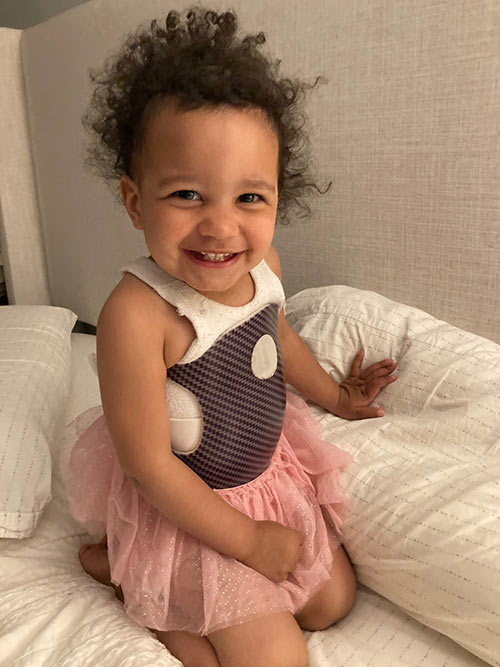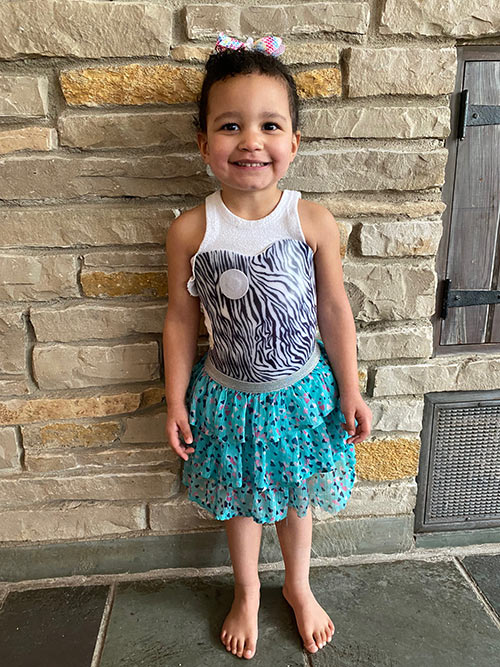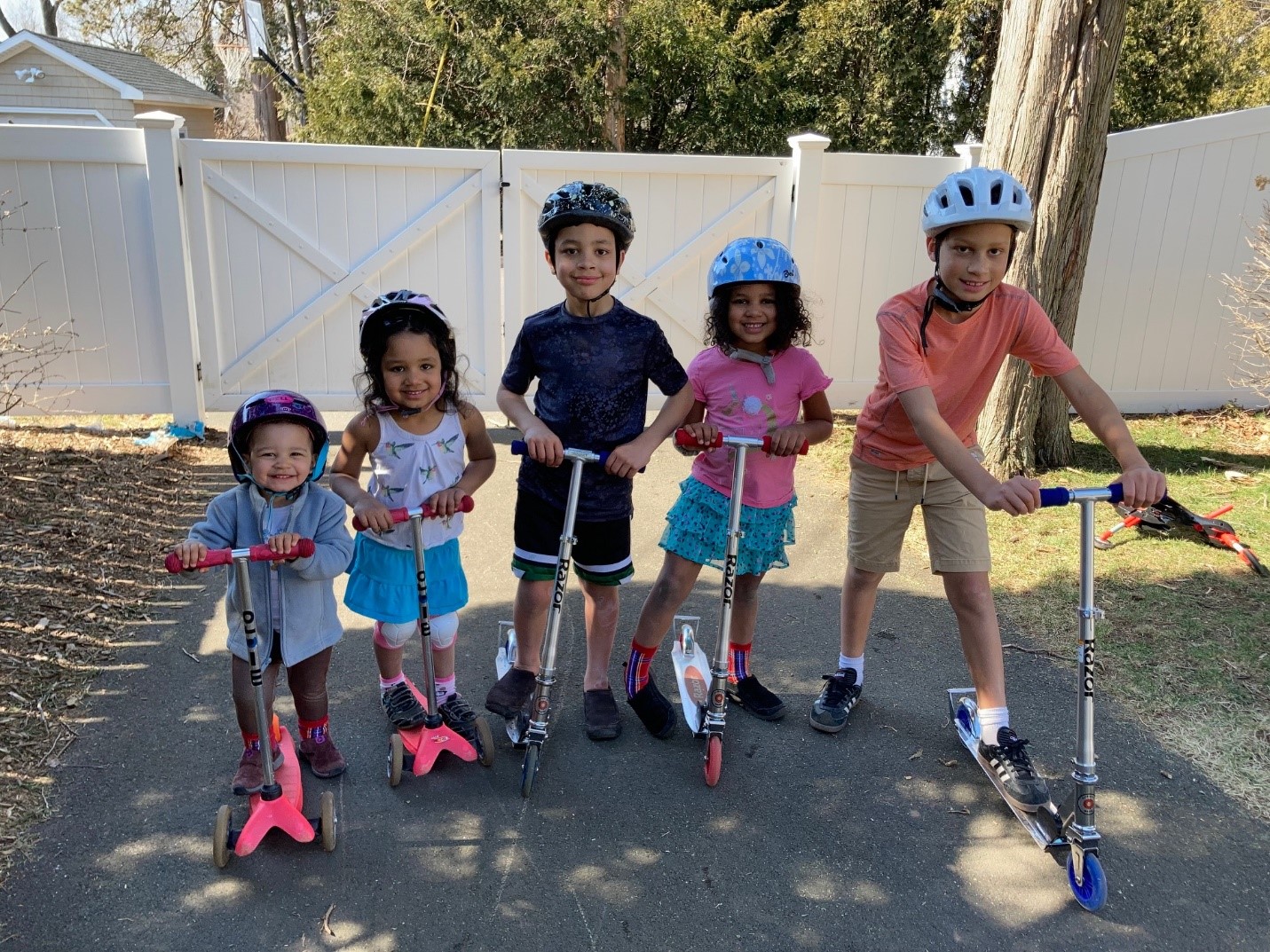A Happy Accident: Pandemic-Related Delays Lead Family to an Alternative to Casting for Infantile Scoliosis
Posted on
When Monica and Stefan McDaniel’s daughter Jeanne was 8 months old and starting to walk, Monica noticed something wasn’t right.

Jeanne in her custom brace for infantile scoliosis.
“I became increasingly worried that something looked wrong about her back,” Monica says. “When she started standing, I could tell her rib cage looked rotated.” In an attempt to identify what might be wrong, Monica Googled “baby with a humpback” and immediately saw pictures that looked like Jeanne’s condition: infantile scoliosis.
Armed with that information, Monica took Jeanne to the pediatrician, who immediately told her that Jeanne probably didn’t have infantile scoliosis because that was extremely rare. “Then the doctor saw her back,” says Monica, “and he agreed something was wrong.”
An Unlikely Diagnosis, A Scary Treatment
“I was very alarmed,” says Monica. “She is our fifth child and we never had serious medical issues with any of our kids.” They had no experience with scoliosis and no family history. Like many people, Jeanne's parents weren’t even aware that scoliosis could affect infants. Infantile idiopathic scoliosis, also called early onset idiopathic scoliosis, is usually diagnosed in children between birth and 3 years old and accounts for just 1% of total idiopathic scoliosis cases.
Monica immediately called a pediatric orthopedist and made an appointment for January 2020. An X-ray showed Jeanne had a 35-degree spinal curve. The doctor would see Jeanne again in April, and if the curve had gotten worse, she would be put in a body cast.
Traditionally, casting was the most common treatment for babies and young children with moderate to severe infantile scoliosis. However, casting requires administering general anesthesia to the child every time a new cast is put on, which could occur as often as every two months. In 2017, the U.S. Food and Drug Administration (FDA) issued a warning that repeated or lengthy use of general anesthesia in children under 3 years old could affect brain development.
In Jeanne’s case, casting was presented as the only option—the doctor never discussed bracing as an alternative that did not require anesthesia. He only mentioned bracing as something that might be done after casting as a follow-up treatment.
Delays Lead to Second Opinion
Jeanne never made her April appointment, which was delayed due to the start of the coronavirus pandemic. An MRI and another X-ray in June showed the curve did not seem to be caused by a spinal column anomaly, but that it had now progressed to 41 degrees. Jeanne was scheduled for her first cast in the operating room and was moments away from the procedure when Monica pointed out that Jeanne had a small area of ringworm on her stomach. She was sent home for eight to 12 weeks to let it clear up.
By August, Monica was growing frustrated at scheduling delays and knew that the longer the curve went untreated, the worse it would get. While she waited for her doctor to get back to her, she joined a Facebook group on infantile scoliosis, where she kept hearing good things about Boston Children's Hospital.
She decided to get in touch to see if they could see her sooner than the other doctor. Not only did she quickly get an appointment, she was introduced to a totally different treatment option—bracing, which would not require general anesthesia. She and her husband Stefan were wary, having previously only heard about casting as an effective treatment at this stage. However, they were eager to trust the Boston doctors and avoid frequent anesthesia and the operating table, if possible.
“Oh wow, this is actually working!”
The measurements and scan for Jeanne’s brace were conducted at the Boston O&P Waltham clinic then the fitting was done by Mauricio Ventura, and Rusty Miller checked everything and made any necessary adjustments.

Jeanne in her custom brace for infantile scoliosis.
“The experience was great,” Monica says, “and we saw results very quickly.” Jeanne was fitted for her brace in September 2020. “We went back in November and Dr. Hresko agreed with our observations that her back was looking more normal. We thought, “Oh wow, we thought we were taking a gamble, but this is actually working!’”
An X-ray in February 2021 showed the curve was down to 18 degrees, and by December 2021 it was down to under 10 degrees. “You can see it if you’re looking closely,” says Monica, “but if it had been like this to start with we wouldn’t have done anything. That’s how minor it is.”
Jeanne wore the brace for about 22 hours a day initially, and now is down to 18 hours a day on the doctor’s advice. She will continue to wear it until she is around 4 years old. “She never complains about it,” says Monica. “She sometimes says it hurts and she wants a break. We give her a break then she has no problem putting it back on.”
Overall, the bracing experience with Boston Children’s and Boston O&P has been a good one. “She had all the right factors and everything aligned,” says Monica. “We’re very happy.”

Jeanne, left, with her 4 siblings, does everything with her cast on.

